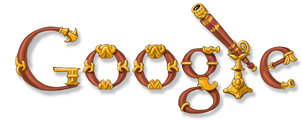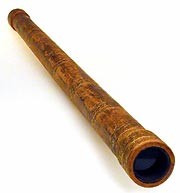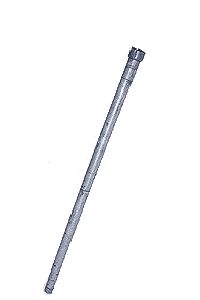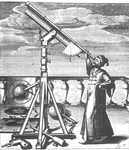400 Years Ago Galileo Invented The Telescope, Thanks Google
Aug 25, 2009 at 9:42am ET by Barry Schwartz
Visiting Google today, you might notice a telescope as the Google logo. If you click on the logo, you are taken to a search result on Google for Galileo’s telescope. 400 year ago today, in the year 1609, Galileo Galileo demonstrated his first telescope. The Google logo, aka Doodle, reminds us of that time in history.
Here is the Google Doodle:
400 Years Ago Galileo Invented The Telescope, Thanks Google
Four Hundred Years Ago, Galileo's Telescope Changed The World
Galileo used his telescope to advance the theory that the Earth was not the center point of creation, which the Roman Catholic Church considered "false and contrary to scripture."
August 25, 2009
By Breffni O'Rourke
Despite the summer heat, the Senate of Venice assembled on this day in 1609 to view a remarkable scientific instrument. It was built by the well-known astronomer and philosopher from Pisa, Galileo Galilei, and could make distant objects appear closer when viewed through one end of its long pipe. It was a telescope.
Galileo's telescope stars in Philadelphia showPHILADELPHIA (Reuters Life!) - A three-foot telescope used by the Italian astronomer Galileo, whose discoveries revolutionized astronomy, is the main attraction at an exhibition at the Franklin Institute
Galileo's telescope stars in Philadelphia show | Lifestyle | Reuters
Build your own working replica of Galileo Galilei's famed telescope and snoop the moons of Jupiter like it's 1609 (hurry, before the Roman Inquisition catches you!). This refracting telescope is over 24 inches long and about 1-1/4 inches in diameter when assembled, with a 700mm focal length and a 20mm eyepiece.
Galileo's Inventions: Telescope is Today's Google DoodleToday is the 400th anniversary of Galileo's telescope, and so Galileo is given the second-highest possible honor: a Google doodle*. Who invented the telescope? Hans Lippershy, Zacharias Janssen and Jacob Metius, but Galileo pimped it out.
Galileo used his steampunk contraption to tell a disbelieving world all about Jupiter's moons, and about our own moon's rocky complexion.
Some of Galileo's other inventions include the first thermometer and the compound microscope, as well as methods of determining gunpowder charges and canon elevation for blasting the crap out of stuff. Because of Galileo, we have Destroyed in Seconds. In general Galileo was really good at improving stuff that other people invented. If he were alive today, he'd have a show on Discovery Channel.
Galileo also drew the ire of the Catholic Church for daring to support the then-radical theory that the Earth revolved around the Sun.
*Of course, the first-highest honor is to be the subject of an Indigo Girls song, which Galileo Galilei can already claim.
Galileo's Inventions: Telescope is Today's Google Doodle |
Galileo's telescope - Home page
Galileo's contributions to the progressive development of the telescope, as well as his revolutionary work to create modern scientific methods, make him one of the greatest luminaries in scientific history. The Franklin Institute is proud to have been selected as the world exclusive host for Galileo, the Medici and the Age of Astronomy, a unique exhibition presented by Officine Panerai at The Franklin Institute during 2009.
Where Is Galileo's Telescope Today?
Galileo's Telescope Replica
400 years later, Galileo's Telescope still survives in the constant care of the Istituto e Museo di Storia della Scienza in Italy. The Museum holds exhibitions on Galileo’s telescope and the observations he made with it. The displays consist of these rare and precious instruments – including the objective lens created by the master and the only two existing telescopes built by Galileo himself. Thanks to Galileo's careful record keeping, craftsmen around the world have recreated Galileo's telescope for museums and replicas are now sold for amateurs and collectors as well!
The story of Galileo's telescope is well known, as he recounted it himself in the Starry Messenger. In July 1609, Galileo was in Venice, when he heard of an invention that allowed distant objects to be seen as distinctly as if they were nearby. In October 1608, a Flemish spectacle-maker by the name of Hans Lipperhey had already applied for a patent (which was refused), and news of the gadget was widespread in Europe by the time Galileo had heard of it. Around the same time, a foreigner turned up in Padua with the instrument; Galileo rushed back to Padua, only to learn that the foreigner had gone to Venice to sell his instrument. Galileo's friend, Paolo Sarpi, had advised the Venetian government against purchasing the instrument from the foreigner, since Galileo could at least match such an invention. By then, Galileo had worked out the principle of the telescope and returned to Venice himself with an eight-power telescope. The Venetian government doubled his salary, though Galileo felt that the original conditions were not honoured.
Galileo and the TelescopeThe science of astronomy took a huge leap forward in the first decade of the 1600s with the invention of the optical telescope and its use to study the night sky. Galileo Galilei did not invent the telescope but was the first to use it systematically to observe celestial objects and record his discoveries. His book, Sidereus nuncius or The Starry Messenger was first published in 1610 and made him famous. In it he reported on his observations of the Moon, Jupiter and the Milky Way. These and subsequent observations and his interpretations of them eventually led to the demise of the geocentric Ptolemaic model of the universe and the adoption of a heliocentric model as proposed in 1543 by Copernicus.
Galileo GalileiGalileo Galilei (15 February 1564[2] – 8 January 1642)[1][3] was an Italian physicist, mathematician, astronomer, and philosopher who played a major role in the Scientific Revolution. His achievements include improvements to the telescope and consequent astronomical observations, and support for Copernicanism. Galileo has been called the "father of modern observational astronomy,"[4] the "father of modern physics,"[5] the "father of science,"[5] and "the Father of Modern Science."[6] Stephen Hawking says, "Galileo, perhaps more than any other single person, was responsible for the birth of modern science."[7]
Galileo Galilei - Wikipedia, the free encyclopedia
Galileo's Telescope
Galileo invented many mechanical devices other than the pump, such as the hydrostatic balance. But perhaps his most famous invention was the telescope. Galileo made his first telescope in 1609, modeled after telescopes produced in other parts of Europe that could magnify objects three times. He created a telescope later that same year that could magnify objects twenty times. With this telescope, he was able to look at the moon, discover the four satellites of Jupiter, observe a supernova, verify the phases of Venus, and discover sunspots. His discoveries proved the Copernican system which states that the earth and other planets revolve around the sun. Prior to the Copernican system, it was held that the universe was geocentric, meaning the sun revolved around the earth.
The Galileo Project | Biography | Telescope
Johannes Hevelius observing with one of his telescopes [click for larger image]
The Telescope
The telescope was one of the central instruments of what has been called the Scientific Revolution of the seventeenth century. It revealed hitherto unsuspected phenomena in the heavens and had a profound influence on the controversy between followers of the traditional geocentric astronomy and cosmology and those who favored the heliocentric system of Copernicus. It was the first extension of one of man's senses, and demonstrated that ordinary observers could see things that the great Aristotle had not dreamed of. It therefore helped shift authority in the observation of nature from men to instruments. In short, it was the prototype of modern scientific instruments. But the telescope was not the invention of scientists; rather, it was the product of craftsmen. For that reason, much of its origin is inaccessible to us since craftsmen were by and large illiterate and therefore historically often invisible. The Galileo Project | Science | Telescope




